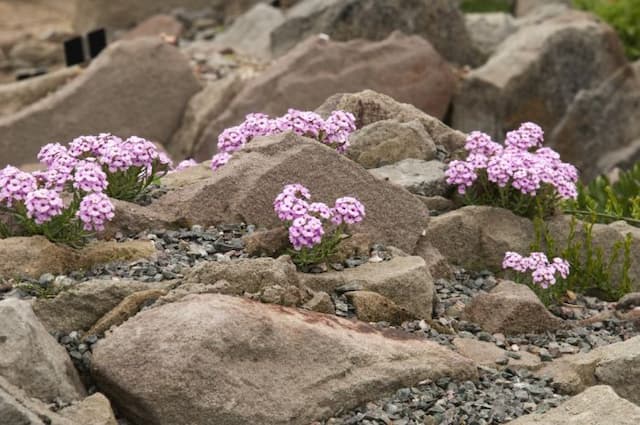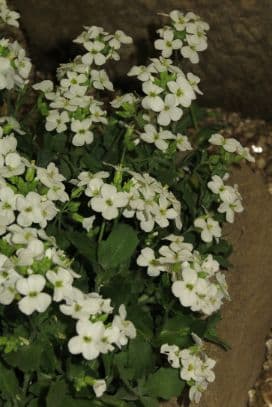Variegated Purple Rock Cress Aubrieta 'Doctor Mules Variegata' (v)

ABOUT
Aubrieta 'Doctor Mules Variegata' is a beautiful, low-growing perennial plant that is widely admired for its stunning foliage and flowers. The leaves of this plant are small and oval-shaped, with a variegated pattern of creamy white and green. These intricate leaves create a dense mat of foliage that serves as an excellent ground cover. During its blooming period, the plant displays a profusion of vibrant flowers. The blooms are typically a rich purple or violet color, and they are small yet quite conspicuous against the variegated leaves. The flowers have a simple, four-petaled shape that adds a delicate texture to the plant's overall appearance. The contrast between the colorful flowers and the patterned foliage makes Aubrieta 'Doctor Mules Variegata' a striking choice for gardeners looking to add visual interest to their landscape. The plant thrives in full sun to partial shade and is often used in rock gardens, along walls, or as edging where it can spill gracefully over the edges. Its low and spreading habit makes it a popular plant for creating a tapestry of color in garden beds and borders.
About this plant
 Names
NamesFamily
Brassicaceae.
Synonyms
Variegated Purple Rock Cress, Doctor Mules Variegated Aubrieta, Rainbow Rock Cress, Variegated False Rockcress.
Common names
Aubrieta 'Doctor Mules Variegata' (v).
 Toxicity
ToxicityTo humans
Aubrieta, commonly known as rock cress, is generally considered non-toxic to humans. However, as with any plant, individual sensitivities can vary, and it's always best to avoid ingesting any plant material if you are unsure of its edibility or potential for allergic reaction. Ingesting any part of the non-toxic plant should not cause poisoning or significant symptoms in most cases.
To pets
The common rock cress is also generally considered non-toxic to pets. If a pet ingests this plant, they are not likely to experience poisoning. Since every animal can react differently, it's still wise to monitor them and consult with a veterinarian if any unusual symptoms occur after ingestion, although serious consequences are unlikely with rock cress.
 Characteristics
CharacteristicsLife cycle
Perennials
Foliage type
Evergreen
Color of leaves
Variegated
Flower color
Purple
Height
4 inches (10 cm)
Spread
24 inches (60 cm)
Plant type
Herb
Hardiness zones
4
Native area
Mediterranean
Benefits
 General Benefits
General Benefits- Easy to grow: Aubrieta is known for being a low-maintenance plant, which is ideal for gardeners of all levels.
- Groundcover: Due to its spreading habit, it is excellent for covering bare spots and suppressing weeds.
- Drought-tolerant: Once established, it can tolerate periods of dryness, making it suitable for drier climates or water-wise gardens.
- Attracts pollinators: The flowers are attractive to bees and butterflies, promoting biodiversity in the garden.
- Spring blooms: It offers vibrant flowers in the springtime, adding color and beauty to the landscape after the winter season.
- Rock gardens: Its ability to grow in rocky or gravelly soils makes it perfect for alpine or rock gardens.
- Edging plant: With its compact growth, Aubrieta is well-suited for borders or edging pathways and garden beds.
- Low-growing habit: Its short stature means it won't overshadow other plants, allowing for layered planting designs.
- Seasonal interest: Variegated leaves of the 'Doctor Mules Variegata' variety provide visual interest even when the plant is not in bloom.
 Medical Properties
Medical PropertiesThis plant is not used for medical purposes.
 Air-purifying Qualities
Air-purifying QualitiesThis plant is not specifically known for air purifying qualities.
 Other Uses
Other Uses- Aubrieta 'Doctor Mules Variegata', commonly known as Variegated Purple Rock Cress, can be used to create a living mulch in garden beds, conserving soil moisture and suppressing weeds.
- The cascading nature of Variegated Purple Rock Cress makes it a stunning choice for adding color and texture to vertical gardens or green walls.
- This plant is suitable for embellishing outdoor containers, hanging baskets, or window boxes where its variegated foliage can complement other plants.
- Variegated Purple Rock Cress can be employed in fairy gardens or miniature landscapes due to its low-growing and spreading habit.
- Gardeners can use this aubrieta variety to highlight and contrast with hardscaping elements like stones, gravel pathways, or rockeries in a garden setting.
- The vigorous growth and dense mat-forming ability of the Variegated Purple Rock Cress make it an effective ground cover for stabilizing slopes and preventing soil erosion.
- Due to its attractive flowers and foliage, the plant can be utilized in seasonal floral arrangements or as a decorative outdoor table centerpiece when planted in shallow bowls.
- Creative gardeners may use Variegated Purple Rock Cress to design intricate garden patterns or borders with its variegated leaves providing textural and color contrast.
- The durable and sun-loving nature of Variegated Purple Rock Cress allows it to be used in xeriscaping projects, promoting water conservation in gardens.
- When planted alongside garden pathways, this aubrieta variety can soften edges while providing a heightened sensory experience with its rich color and texture.
Interesting Facts
 Feng Shui
Feng ShuiThe Aubrieta is not used in Feng Shui practice.
 Zodiac Sign Compitability
Zodiac Sign CompitabilityThe Aubrieta is not used in astrology practice.
 Plant Symbolism
Plant Symbolism- Persistence: Aubrieta, commonly known as Rock Cress, often symbolizes determination and an ability to thrive in challenging conditions, as it usually grows in rocky, mountainous areas where other plants might struggle. 'Doctor Mules Variegata' shares this symbolism by virtue of being a cultivar of Aubrieta.
- Survival: Due to its hardy nature, Rock Cress is frequently associated with survival and overcoming adversity. It can symbolize resiliency in tough environments.
- Beauty: With its vibrant, variegated foliage and flowers, Rock Cress ('Doctor Mules Variegata') is often representative of beauty and the idea that there is elegance to be found even in harsh or unexpected places.
- Grounding: As a plant that typically covers the ground, spreading out in a mat-like form, Rock Cress can symbolize grounding and stability, suggesting a foundation upon which other things can build or depend.
 Water
WaterRock cress, including the variegated 'Doctor Mules' variety, prefers evenly moist soil but does not tolerate waterlogged conditions. You should water these plants when the top inch of soil feels dry to the touch. Depending on weather conditions, this might be approximately once a week, but it's essential to check the soil moisture before watering. An average amount to water might be about 16-24 ounces for smaller plants or up to 1 gallon for larger, established plants in garden beds, ensuring you water directly at the base and avoid wetting the foliage to prevent disease.
 Light
LightRock cress thrives best in full sun conditions where it can receive at least 6 to 8 hours of direct sunlight daily. Planting it in a spot that gets ample morning sunlight with some afternoon shade is ideal, especially in hotter climates. However, it is flexible enough to also tolerate partial shade, especially in regions with very intense sun.
 Temperature
TemperatureRock cress is hardy and can withstand temperature fluctuations, growing well in typical garden environments. The plant can survive a minimum temperature of roughly 20 degrees Fahrenheit and can tolerate maximum temperatures that reach well into the 80s or 90s Fahrenheit. Ideally, it prefers a temperate range, enjoying the cooler end of the spectrum, where nighttime temperatures might dip to around 60 degrees Fahrenheit.
 Pruning
PruningRock cress should be pruned to promote bushier growth and to remove any spent flowers or damaged foliage. Pruning is best done right after flowering to encourage a second bloom and to maintain its compact form. Typically, pruning once per year is adequate, removing only a few inches off the top to shape the plant. The best time for pruning is late spring or early summer, immediately after the first bloom.
 Cleaning
CleaningAs needed
 Soil
SoilVariegated Aubrieta prefers well-draining soil with a slightly alkaline pH between 6.5 and 7.5. A mix with grit or perlite and compost or loamy soil works best to provide the necessary drainage and nutrients.
 Repotting
RepottingVariegated Aubrieta typically does not need frequent repotting as it is a low-growing perennial. Repot only when it outgrows its container, which may be every 2-3 years.
 Humidity & Misting
Humidity & MistingVariegated Aubrieta thrives in average garden humidity levels. It does not require high humidity and can tolerate dry air typical of outdoor conditions.
 Suitable locations
Suitable locationsIndoor
Ensure bright light and good air flow.
Outdoor
Plant in full sun with well-draining soil.
Hardiness zone
4-9 USDA
 Life cycle
Life cycleAubrieta 'Doctor Mules Variegata', commonly known as Rainbow Rock Cress, starts its life cycle with seed germination, typically in early spring, when soil temperatures warm up. Once the seedlings have emerged, they develop into a low mat-forming perennial, characterized by variegated leaves that provide ground cover. Throughout spring, the plant blooms with small purple flowers, adding color and attracting pollinators to the garden. After flowering, seed set occurs, allowing for dispersal and new plant establishment. As temperatures cool in autumn, the plant may experience a semi-dormant phase where growth slows. Rainbow Rock Cress is a hardy plant that can survive winter conditions, reemerging vigorously the next spring to continue its life cycle.
 Propogation
PropogationPropogation time
Spring to early summer
The most common way to propagate Aubrieta 'Doctor Mules Variegata', commonly known as variegated purple rock cress, is through cuttings. This method is typically done in early summer when the plant's growth is vigorous. Gardeners will select healthy, non-flowering shoots and cut a length of approximately 2 to 4 inches (5 to 10 cm). The cut end is then dipped in rooting hormone powder to encourage root development and planted in a well-draining potting mix. The cutting should be kept moist and placed in a warm, well-lit area but out of direct sunlight until roots establish, which usually takes a few weeks. Once rooted, the new plants can be transplanted into their permanent positions in the garden.





![Aubrieta [Axcent Light Blue]](/_next/image?url=https%3A%2F%2Fplants-admin.emdemapps.com%2Fimages%2Fplants%2F%2Fimages%2F604b5e7128866.png&w=640&q=75)



